Sources
- ↑ Ilfeld, Frederic W. (May 1948). "Antireticular Cytotoxic Serum: A Review". J Natl Med Assoc. 40 (3): 116–119.
- World Book Encyclopedia, 1967 edition, p. 28
Anti-reticular Cytotoxic Serum is made from the blood of a rabbit that has been injected with homogenized cadaver spleen and rib marrow. In small quantities it can aid animal growth, but is toxic in large doses. It was first developed by Alexander A. Bogomolets in 1936. [1]
"It was a "miracle" that Professor Bogomolets made dying people walk with blood of cadavers circulating through their bodies, or hoped to extend our life-span for 150 years with the help of the A.C.S serum" - Red Miracle: The Story of Soviet Medicine; by Edward Podolsky

Paul Ehrlich was a Nobel Prize-winning German physician and scientist who worked in the fields of hematology, immunology, and antimicrobial chemotherapy. Among his foremost achievements were finding a cure for syphilis in 1909 and inventing the precursor technique to Gram staining bacteria. The methods he developed for staining tissue made it possible to distinguish between different types of blood cells, which led to the ability to diagnose numerous blood diseases.
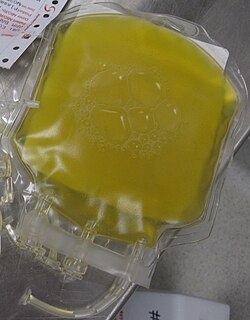
Blood plasma is a light amber-colored liquid component of blood in which blood cells are absent, but contains proteins and other constituents of whole blood in suspension. It makes up about 55% of the body's total blood volume. It is the intravascular part of extracellular fluid. It is mostly water, and contains important dissolved proteins, glucose, clotting factors, electrolytes, hormones, carbon dioxide, and oxygen. It plays a vital role in an intravascular osmotic effect that keeps electrolyte concentration balanced and protects the body from infection and other blood-related disorders.

A lymphocyte is a type of white blood cell (leukocyte) in the immune system of most vertebrates. Lymphocytes include natural killer cells, T cells, and B cells. They are the main type of cell found in lymph, which prompted the name "lymphocyte". Lymphocytes make up between 18% and 42% of circulating white blood cells.
Cytotoxicity is the quality of being toxic to cells. Examples of toxic agents are an immune cell or some types of venom, e.g. from the puff adder or brown recluse spider.

Serum is the fluid and solute component of blood which does not play a role in clotting. It may be defined as blood plasma without the clotting factors, or as blood with all cells and clotting factors removed. Serum includes all proteins not used in blood clotting; all electrolytes, antibodies, antigens, hormones; and any exogenous substances. Serum does not contain white blood cells (leukocytes), red blood cells (erythrocytes), platelets, or clotting factors.

Cerebral edema is excess accumulation of fluid (edema) in the intracellular or extracellular spaces of the brain. This typically causes impaired nerve function, increased pressure within the skull, and can eventually lead to direct compression of brain tissue and blood vessels. Symptoms vary based on the location and extent of edema and generally include headaches, nausea, vomiting, seizures, drowsiness, visual disturbances, dizziness, and in severe cases, coma and death.
A Coombs test, also known as antiglobulin test (AGT), is either of two blood tests used in immunohematology. They are the direct and indirect Coombs tests. The direct Coombs test detects antibodies that are stuck to the surface of the red blood cells. Since these antibodies sometimes destroy red blood cells, a person can be anemic and this test can help clarify the condition. The indirect Coombs detects antibodies that are floating freely in the blood. These antibodies could act against certain red blood cells and the test can be done to diagnose reactions to a blood transfusion.

My Education: A Book of Dreams (1995) (ISBN 0-14-009454-7) is the final novel by William S. Burroughs to be published before his death in 1997. It is a collection of dreams, taken from various decades, along with a few comments about the War on Drugs and paragraphs created with the cut-up technique. The book is dedicated to Michael Emerton.

Dr. Jekyll and Sister Hyde is a 1971 British horror film directed by Roy Ward Baker based on the 1886 novella Strange Case of Dr Jekyll and Mr Hyde by Robert Louis Stevenson. The film was made by British studio Hammer Film Productions and was their third adaptation of the story after The Ugly Duckling and The Two Faces of Dr. Jekyll. The film is notable for showing Jekyll transform into a female Hyde; it also incorporates into the plot aspects of the historical Jack the Ripper and Burke and Hare cases. The title characters were played by the film's stars, Ralph Bates and Martine Beswick.
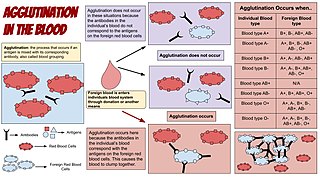
Agglutination is the clumping of particles. The word agglutination comes from the Latin agglutinare.

Oleksandr Oleksandrovych Bogomolets was a Soviet and Ukrainian pathophysiologist.

Tuftsin is a tetrapeptide located in the Fc-domain of the heavy chain of immunoglobulin G. It has an immunostimulatory effect. It is named for Tufts University where it was first discovered in 1983.
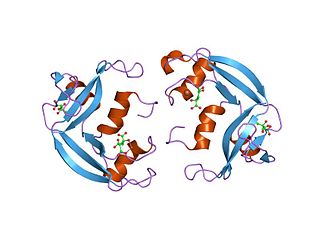
Eosinophil cationic protein (ECP) also known as ribonuclease 3 is a basic protein located in the eosinophil primary matrix. In humans, the eosinophil cationic protein is encoded by the RNASE3 gene.
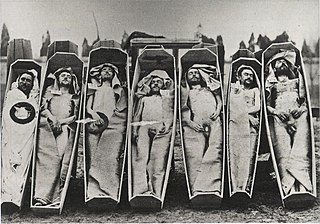
A cadaver or corpse is a dead human body that is used by medical students, physicians and other scientists to study anatomy, identify disease sites, determine causes of death, and provide tissue to repair a defect in a living human being. Students in medical school study and dissect cadavers as a part of their education. Others who study cadavers include archaeologists and arts students.

Cephaloridine is a first-generation semisynthetic derivative of antibiotic cephalosporin C. It is a Beta lactam antibiotic, like penicillin. Its chemical structure contains 3 cephems, 4 carboxyl groups and three pyridinium methyl groups.

α-Parinaric acid is a conjugated polyunsaturated fatty acid. Discovered by Tsujimoto and Koyanagi in 1933, it contains 18 carbon atoms and 4 conjugated double bonds. The repeating single bond-double bond structure of α-parinaric acid distinguishes it structurally and chemically from the usual "methylene-interrupted" arrangement of polyunsaturated fatty acids that have double-bonds and single bonds separated by a methylene unit (−CH2−). Because of the fluorescent properties conferred by the alternating double bonds, α-parinaric acid is commonly used as a molecular probe in the study of biomembranes.
Streptolysins are two hemolytic exotoxins from Streptococcus. Types include streptolysin O, which is oxygen-labile, and streptolysin S, which is oxygen-stable.
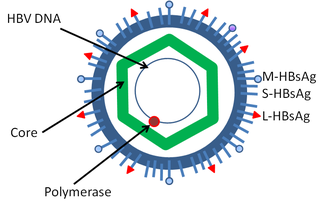
HBcAg is a hepatitis B viral protein. It is an indicator of active viral replication; this means the person infected with Hepatitis B can likely transmit the virus on to another person.

Tetrahydrocannabinolic acid is a precursor of tetrahydrocannabinol (THC), an active component of cannabis.
Passive antibody therapy, also called serum therapy, is a subtype of passive immunotherapy that administers antibodies to target and kill pathogens or cancer cells. It is designed to draw support from foreign antibodies that are donated from a person, extracted from animals, or made in the laboratory to elicit an immune response instead of relying on the innate immune system to fight disease. It has a long history from the 18th century for treating infectious diseases and is now a common cancer treatment. The mechanism of actions include: antagonistic and agonistic reaction, complement-dependent cytotoxicity (CDC), and antibody-dependent cellular cytotoxicity (ADCC).